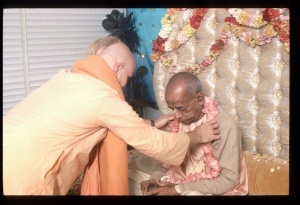CC Madhya 17.179 (1975): Difference between revisions
(Vanibot #0027: CCMirror - Mirror CC's 1996 edition to form a basis for 1975) |
(Vanibot #0020: VersionCompareLinker - added a link to the Version Compare feature) |
||
| Line 2: | Line 2: | ||
<div style="float:left">'''[[Sri Caitanya-caritamrta (1975)|Śrī Caitanya-caritāmṛta (1975)]] - [[CC Madhya (1975)|Madhya-līlā]] - [[CC Madhya 17 (1975)|Chapter 17: The Lord Travels to Vṛndāvana]]'''</div> | <div style="float:left">'''[[Sri Caitanya-caritamrta (1975)|Śrī Caitanya-caritāmṛta (1975)]] - [[CC Madhya (1975)|Madhya-līlā]] - [[CC Madhya 17 (1975)|Chapter 17: The Lord Travels to Vṛndāvana]]'''</div> | ||
<div style="float:right">[[File:Go-previous.png|link=CC Madhya 17.178 (1975)|Madhya-līlā 17.178]] '''[[CC Madhya 17.178 (1975)|Madhya-līlā 17.178]] - [[CC Madhya 17.180 (1975)|Madhya-līlā 17.180]]''' [[File:Go-next.png|link=CC Madhya 17.180 (1975)|Madhya-līlā 17.180]]</div> | <div style="float:right">[[File:Go-previous.png|link=CC Madhya 17.178 (1975)|Madhya-līlā 17.178]] '''[[CC Madhya 17.178 (1975)|Madhya-līlā 17.178]] - [[CC Madhya 17.180 (1975)|Madhya-līlā 17.180]]''' [[File:Go-next.png|link=CC Madhya 17.180 (1975)|Madhya-līlā 17.180]]</div> | ||
{{CompareVersions|CC|Madhya 17.179|CC 1975|CC 1996}} | |||
{{RandomImage}} | {{RandomImage}} | ||
==== TEXT 179 ==== | ==== TEXT 179 ==== | ||
<div class="verse"> | <div class="verse"> | ||
:yadyapi | :yadyapi 'sanoḍiyā' haya seita brāhmaṇa | ||
:sanoḍiyā-ghare sannyāsī nā kare bhojana | :sanoḍiyā-ghare sannyāsī nā kare bhojana | ||
</div> | </div> | ||
| Line 32: | Line 31: | ||
<div class="purport"> | <div class="purport"> | ||
In northwestern India, vaiśyas are divided | In northwestern India, vaiśyas are divided in various subdivisions. Śrīla Bhaktivinoda Ṭhākura points out that they are divided as Āgaraoyālā, Kālaoyāra and Sānoyāḍa. Out of them, the Āgaraoyālās are supposed to be first-class vaiśyas, and the Kālaoyāras and Sānoyāḍas are considered lower due to their occupational degradation. The Kālaoyāras generally take wine and other intoxicants. Although they are vaiśyas, they are considered to belong to a lower class. The priests who guide the Kālaoyāras and the Sānoyāḍas are called Sanoḍiyā brāhmaṇas. Śrīla Bhaktivinoda Ṭhākura states that the word sānoyāḍa in Bengal indicates suvarṇa-vaṇik. In Bengal there are priests who guide the suvarṇa-vaṇik community, which is also considered a low class. There is little difference between the Sānoyāḍa and the suvarṇa-vaṇik. Generally the suvarṇa-vaṇiks are bankers dealing in gold and silver. In western India, the Āgaraoyālās also belong to the banking profession. This is the original business of the suvarṇa-vaṇik or Āgaraoyālā community. Historically, the Āgaraoyālās came from the up-country named Ayodha, and the suvarṇa-vaṇik community came from Ayodha. It appears that the suvarṇa-vaṇiks and the Āgaraoyālās belong to the same community. The Sanoḍiyā brāhmaṇas were the guides of the Kālaoyāra and Sānoyāḍa. They are therefore considered to be lower-class brāhmaṇas, and a sannyāsī is not allowed to take alms or food from them. However, Śrī Caitanya Mahāprabhu accepted lunch cooked by a Sanoḍiyā brāhmaṇa simply because he belonged to Mādhavendra Purī's community. Śrīla Mādhavendra Purī was the spiritual master of Īśvara Purī, who was the spiritual master of Śrī Caitanya Mahāprabhu. Thus a spiritual relationship is established on the spiritual platform without consideration of material inferiority or superiority. | ||
</div> | </div> | ||
Latest revision as of 10:35, 27 January 2020

A.C. Bhaktivedanta Swami Prabhupada
TEXT 179
- yadyapi 'sanoḍiyā' haya seita brāhmaṇa
- sanoḍiyā-ghare sannyāsī nā kare bhojana
SYNONYMS
yadyapi—although; sanoḍiyā—a priest of the Sanoḍiyā community; haya—was; seita—that; brāhmaṇa—brāhmaṇa; sanoḍiyā-ghare—in the house of a Sanoḍiyā (goldsmith); sannyāsī—a person in the renounced order of life; nā kare bhojana—does not accept food.
TRANSLATION
The brāhmaṇa belonged to the Sanoḍiyā brāhmaṇa community, and a sannyāsī does not accept food from such a brāhmaṇa.
PURPORT
In northwestern India, vaiśyas are divided in various subdivisions. Śrīla Bhaktivinoda Ṭhākura points out that they are divided as Āgaraoyālā, Kālaoyāra and Sānoyāḍa. Out of them, the Āgaraoyālās are supposed to be first-class vaiśyas, and the Kālaoyāras and Sānoyāḍas are considered lower due to their occupational degradation. The Kālaoyāras generally take wine and other intoxicants. Although they are vaiśyas, they are considered to belong to a lower class. The priests who guide the Kālaoyāras and the Sānoyāḍas are called Sanoḍiyā brāhmaṇas. Śrīla Bhaktivinoda Ṭhākura states that the word sānoyāḍa in Bengal indicates suvarṇa-vaṇik. In Bengal there are priests who guide the suvarṇa-vaṇik community, which is also considered a low class. There is little difference between the Sānoyāḍa and the suvarṇa-vaṇik. Generally the suvarṇa-vaṇiks are bankers dealing in gold and silver. In western India, the Āgaraoyālās also belong to the banking profession. This is the original business of the suvarṇa-vaṇik or Āgaraoyālā community. Historically, the Āgaraoyālās came from the up-country named Ayodha, and the suvarṇa-vaṇik community came from Ayodha. It appears that the suvarṇa-vaṇiks and the Āgaraoyālās belong to the same community. The Sanoḍiyā brāhmaṇas were the guides of the Kālaoyāra and Sānoyāḍa. They are therefore considered to be lower-class brāhmaṇas, and a sannyāsī is not allowed to take alms or food from them. However, Śrī Caitanya Mahāprabhu accepted lunch cooked by a Sanoḍiyā brāhmaṇa simply because he belonged to Mādhavendra Purī's community. Śrīla Mādhavendra Purī was the spiritual master of Īśvara Purī, who was the spiritual master of Śrī Caitanya Mahāprabhu. Thus a spiritual relationship is established on the spiritual platform without consideration of material inferiority or superiority.